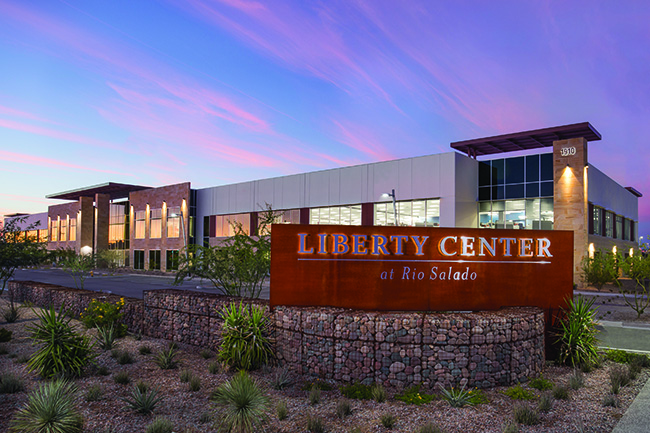With the real estate market taking a positive turn in investments, buyers and sellers are beginning to think about creating long-term office locations. While the future of the dynamic market is undetermined, tenants know they want to create work-play environments rather than a block of concrete buildings.
“Capital is definitely flowing into Phoenix,” says Jami E. Vallelonga, general manager for The Esplanade. “The investment market was very active in 2015 across all commercial property types — from retail to industrial — and 2016 looks like it will continue this trend.”
Larry Downey, vice chairman at Cushman & Wakefield, explains that Phoenix is ranked eighth out of the 85 best real estate markets in the country. With the real estate market improving, managers are looking toward the future and what the next generation desires.
Now that those from the Millennial generation are coming into play, people are demanding a new type of office and retail experience. While executives are looking to embark on new projects, IREM and CBRE members stress that an old building with new renovations and attractions will appeal to tenants.
“Base building systems have to be functional to keep tenants safe and comfortable,” Vallelonga says. “With that said, no one wants to lease space at an address where the air conditioning is great but the place has zero curb appeal.”
Today, an office space is more than simply a location. According to Walter Crutchfield, partner with Vintage Partners, people want to work in an area that is considered an up-and-coming site.
“Much more thought is being given to creating the kinds of places that kick-start demand, including collaborating with visionary restaurateurs when designing space in the first place, and not just building a space and waiting,” Crutchfield says. “It’s a much more organic and collaborative process than the traditional, ‘if you build it, they will come.’”
Tenants want a work and play environment, but much more thought goes into the construction of the surrounding area than simply throwing up a few chain restaurants.
Curb and functionality appeal
“You need to take into account how people actually use a space, what services they require and what kind of community people want to build their lives around,” Crutchfield says.
By creating an environment that is more than a city block of concrete office buildings, tenants create a more competitive investment spectrum while attracting people to the area.
“Office users need great work spaces with central locations” Crutchfield says. “Restaurants need cool spaces that create warmth and community, and multifamily users want to live in a place that offers all of the above.”
While many new restaurants are popping up around industrial and office locations, there is concern about how long these spots will last and continue to add curb appeal.
“Obviously you can reach a point of oversaturation,” Crutchfield adds, “but I truly believe a rising tide lifts all ships.”
Although spaces encompassed by restaurants are attractive to tenants, there is still an obstacle pertaining to larger, vacant, big box office space around 350,000 square feet.
Grocery and parking perplexities
“We need more big boxes and we need grocery stores to attract tenants,” says Dave Cheatham, president of Velocity Retail Group.
Though downtown Phoenix has a few grocery stores, they are outdated and scattered.
“In order to have urban grocery stores, you need two-story parking structures,” Cheatham says. “There’s a demand for it, but the city has to work with local law enforcement parameters.”
Despite a demand for grocery stores, tenants are still filling up office locations. However, there are those who insist that industrial space holds no competition to other forms of real estate.
“While infill projects are ‘hot,’ the ability to build infill remains limited with short supply of sites,” says Mike Beall, executive managing director at Cushman & Wakefield. “Many that are available are purchased by multifamily developers who can pay more since they see higher returns on their properties than offices.”
Beall says investors do not view returns as substantial enough to continue special development office projects. In the investors’ eyes, the issue preventing large returns revolves around the space’s pre-lease agreement.
“(Investors) typically want a 20 percent to 50 percent pre-lease commitment, depending on the size of the proposed project,” Beall says. “The larger the project, the larger percent of a pre-lease commitment they want.”
Downey says managers are looking to invest in collaborative office space. Liberty Center, at the corner of Priest Drive and Rio Salado Parkway is a Class A, 1-million-square-foot collaborative office space. The center, which is within driving distance from a number of key locations, offers large floor plans to create individual work environments. Liberty Center abides by U.S Green Building Council certifications and offers LED lighting, open ceilings and an atrium lobby. One of the most appealing elements of the center is the six parking spaces per 1,000 square feet of leased space.
“Everyone wants to drive,” Downey says.
With the anticipated increase of 60,000 jobs coming to the Phoenix area, executives admit that parking is, and will be, a huge factor in whether tenants decide to lease any type of location.
“We are currently trying to lease an area that has a 2-to-1,000-square-foot parking ratio,” says Curt Kremer managing director of EverWest Real Estate Partners. “However, the location is in an urban area and it’s accessible to trains”
“If you’re building is cool enough, it doesn’t matter what kind of parking you have,” says Andrew Cheney principal for Lee and Associates.
While parking and grocery shopping remain issues that need to be solved, the market is still absorbing 10 to 15 percent of what it was doing pre-recession.
“I would allow the Valley an opportunistic perspective,” Cheney says.




